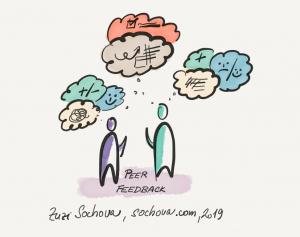 The next topic in my Agile HR series focuses on evaluations and performance reviews. Once you hire the right person to the team, it’s time to start thinking about evaluations and performance reviews. In a traditional organization, it was pretty simple. Each employee got a task assigned, each task can be evaluated and linked to particular KPI. In Agile organization, it’s not that simple as multiple people collaborate on the same task and even if you try to set some KPIs at the beginning of the year, they mostly become irrelevant somewhere on the way so there is nothing to evaluate at the end of the year.
The next topic in my Agile HR series focuses on evaluations and performance reviews. Once you hire the right person to the team, it’s time to start thinking about evaluations and performance reviews. In a traditional organization, it was pretty simple. Each employee got a task assigned, each task can be evaluated and linked to particular KPI. In Agile organization, it’s not that simple as multiple people collaborate on the same task and even if you try to set some KPIs at the beginning of the year, they mostly become irrelevant somewhere on the way so there is nothing to evaluate at the end of the year.
The most simple practice used in agile environments is to set a team goal instead of an individual. There is still risk that the goal becomes obsolete during the year, but at least you support the team collaborative culture. The slightly better option is to break the year cadence and create shorter goals. After all, there is no magical on the year cadence when we deliver product regularly. A good practice is to let teams design their own goals, but you need a high level of trust in order to be able to move this direction. Some companies like OKRs, however, I see them too close to the traditional KPIs. Those were still traditional mindset practices spiced by little agility.
A good step on the way is replacing evaluation part by coaching conversation focused on employee development. As every coaching conversation, it is not about the coach but coachee (employee in this case) and is focused on raising the awareness of the person about themselves and their abilities and potentials. When done well, it can skyrocket people performance. But here is the downside – unfortunately, not many managers are good coaches which is a limit in most organizations.
Finally, if you are ready to be truly agile, how about if you do it in an agile manner and run regular frequent retrospectives instead of any form of evaluation. Together with radical transparency, it will create enough clarity about performance towards the Sprint Goal, product vision and entire organizational purpose so people can adapt in a very efficient way. Simple and powerful. Indeed we talk about not only team retrospective which brings so powerful peers feedback but also overall retrospective as it is designed for example in LeSS and organizational retrospective which can be facilitated for example in a form of world cafe or open space. All together it will engage employees in solving team, cross-team, and organizational issues, and increase their motivation to come up with creative and innovative solutions how to be better in delivering value and achieving the organizational purpose.
The frequent retrospective cadence brings regular feedback that allows fast changes and small improvements on day to day basis which as a result prevents big disappointments and surprises of traditional performance reviews which often brings demotivation and stress. Issues got solved sooner, before they are too big and poison the team or department and people get help to work on those issues early, ideally from their peers. You might not be ready for that tomorrow, as the culture of transparency and trust is not there yet, but you can go step by step until no-one misses any KPIs, performance reviews or any formal evaluations and frequent feedback, inspection, and adaptation become the regular way of work.
At this stage, we often stop using the name of Agile HR and change it to Talent Development where the entire focus of the HR is changing to support overall employee journey and development. Supporting coaching and mentoring programs, and creating an environment for effective peer feedback are just a few ideas about where to start.

